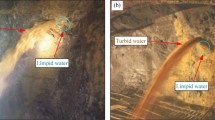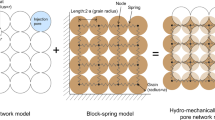Abstract
Chemical dissolution-front instability (CDFI) problems usually involve multiple temporal and spatial scales, as well as multiple processes. A key issue associated with solving a CDFI problem in a fluid-saturated rock is to mathematically establish a theoretical criterion, which can be used to judge the instability of a chemical dissolution-front (CDF) propagating in the fluid-saturated rock. This theoretical paper deals with how two different mathematical schemes can be used to precisely establish such a theoretical criterion in a purely mathematical manner, rather than in a numerical simulation manner. The main distinguishment between these two different mathematical schemes is that in the first mathematical scheme, a curved surface coordinate system is used, while in the second mathematical scheme, a planar surface coordinate system is employed. In particular, all the key mathematical deduction steps associated with using these two different mathematical schemes are described and discussed in great detail. The main theoretical outcomes of this study have demonstrated that (1) two different mathematical schemes under consideration can produce exactly the same theoretical criterion; (2) the main advantage of using the first mathematical scheme is that the interface conditions at the curved interface between the downstream and upstream regions can be easily described mathematically; (3) the main advantage of using the second mathematical scheme is that the first-order perturbation equations of the CDFI problem can be easily described in a purely mathematical manner.
Similar content being viewed by others
References
Chadam J, Hoff D, Merino E, et al. Reactive infiltration instabilities. IMA J Appl Math, 1986, 36: 207–221
Chadam J, Ortoleva P, Sen A. A weekly nonlinear stability analysis of the reactive infiltration interface. IMA J App Math, 1988, 48: 1362–1378
Ortoleva P, Chadam J, Merino E, et al. Geochemical self-organization II; the reactive-infiltration instability. Am J Sci, 1987, 287: 1008–1040
Sherwood J D. Stability of a plane reaction front in a porous medium. Chem Eng Sci, 1987, 42: 1823–1829
Hinch E J, Bhatt B S. Stability of an acid front moving through porous rock. J Fluid Mech, 1990, 212: 279–288
Zhao C, Hobbs B E, Hornby P, et al. Theoretical and numerical analyses of chemical-dissolution front instability in fluid-saturated porous rocks. Int J Numer Anal Meth Geomech, 2008, 32: 1107–1130
Ormond A, Ortoleva P. Numerical modeling of reaction-induced cavities in a porous rock. J Geophys Res, 2000, 105: 16737–16747
Chen J S, Liu C W. Numerical simulation of the evolution of aquifer porosity and species concentrations during reactive transport. Comput Geosciences, 2002, 28: 485–499
Chen J S, Liu C W. Interaction of reactive fronts during transport in a homogeneous porous medium with initial small non-uniformity. J Contam Hydrol, 2004, 72: 47–66
Zhao C, Hobbs B E, Ord A. Theoretical analyses of acidization dissolution front instability in fluid-saturated carbonate rocks. Int J Numer Anal Meth Geomech, 2013, 37: 2084–2105
Fredd C N, Fogler H S. Influence of transport and reaction on wormhole formation in porous media. AIChE J, 1998, 44: 1933–1949
Golfier F, Zarcone C, Bazin B, et al. On the ability of a Darcy-scale model to capture wormhole formation during the dissolution of a porous medium. J Fluid Mech, 2002, 457: 213–254
Panga M K R, Ziauddin M, Balakotaiah V. Two-scale continuum model for simulation of wormholes in carbonate acidization. AIChE J, 2005, 51: 3231–3248
Cohen C E, Ding D, Quintard M, et al. From pore scale to wellbore scale: Impact of geometry on wormhole growth in carbonate acidization. Chem Eng Sci, 2008, 63: 3088–3099
Kalia N, Balakotaiah V. Modeling and analysis of wormhole formation in reactive dissolution of carbonate rocks. Chem Eng Sci, 2007, 62: 919–928
Kalia N, Balakotaiah V. Effect of medium heterogeneities on reactive dissolution of carbonates. Chem Eng Sci, 2009, 64: 376–390
Imhoff P T, Miller C T. Dissolution fingering during the solubilization of nonaqueous phase liquids in saturated porous media: 1. Model predictions. Water Resour Res, 1996, 32: 1919–1928
Chen J S, Liu C W, Lai G X, et al. Effects of mechanical dispersion on the morphological evolution of a chemical dissolution front in a fluid-saturated porous medium. J Hydrol, 2009, 373: 96–102
Wangen M. Stability of reaction-fronts in porous media. Appl Math Model, 2013, 37: 4860–4873
Zhao C B, Hobbs B, Ord A. A new alternative approach for investigating acidization dissolution front propagation in fluid-saturated carbonate rocks. Sci China Tech Sci, 2017, 60: 1197–1210
Zhao C B, Hobbs B, Ord A. A unified theory for sharp dissolution front propagation in chemical dissolution of fluid-saturated porous rocks. Sci China Tech Sci, 2019, 62: 163–174
Szymczak P, Ladd A J C. Reactive-infiltration instabilities in rocks. Part 2. Dissolution of a porous matrix. J Fluid Mech, 2014, 738: 591–630
Lai K H, Chen J S, Liu C W, et al. Effect of medium permeability anisotropy on the morphological evolution of two non-uniformities in a geochemical dissolution system. J Hydrol, 2016, 533: 224–233
Zhao C, Hobbs B, Ord A. Effects of different numerical algorithms on simulation of chemical dissolution-front instability in fluid-saturated porous rocks. J Cent South Univ, 2018, 25: 1966–1975
Zhao C, Hobbs B E, Ord A. Analytical solution for dissolution-timescale reactive transport in fluid-saturated porous rocks. Int J Geomech, 2018, 18: 04018037
Zhao C, Hobbs B E, Ord A. An interface-condition substitution strategy for theoretical study of dissolution-timescale reactive infiltration instability in fluid-saturated porous rocks. Int J Numer Anal Methods Geomech, 2019, 43: 1576–1593
Zhao C B, Hobbs B, Ord A. Transient-state instability analysis of dissolution-timescale reactive infiltration in fluid-saturated porous rocks: Purely mathematical approach. Sci China Tech Sci, 2020, 63: 319–328
Grodzki P, Szymczak P. Reactive-infiltration instability in radial geometry: From dissolution fingers to star patterns. Phys Rev E, 2019, 100: 033108
Carman P C. Flow of Gases through Porous Media. New York: Academic Press, 1956
Zhao C, Hobbs B E, Ord A. Chemical dissolution-front instability associated with water-rock reactions in groundwater hydrology: Analyses of porosity-permeability relationship effects. J Hydrol, 2016, 540: 1078–1087
Author information
Authors and Affiliations
Corresponding author
Additional information
This work was supported by the National Natural Science Foundation of China (Grant Nos. 42030809 and 72088101).
Rights and permissions
About this article
Cite this article
Zhao, C., Hobbs, B. & Ord, A. Two different mathematical schemes for solving chemical dissolution-front instability problems in fluid-saturated rocks. Sci. China Technol. Sci. 65, 147–156 (2022). https://doi.org/10.1007/s11431-021-1878-9
Received:
Accepted:
Published:
Issue Date:
DOI: https://doi.org/10.1007/s11431-021-1878-9




